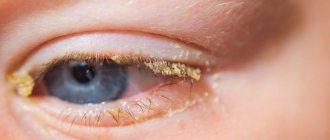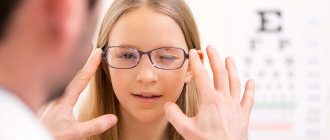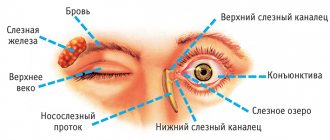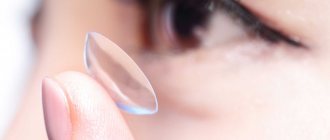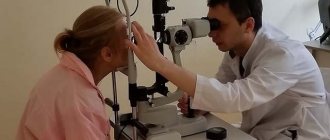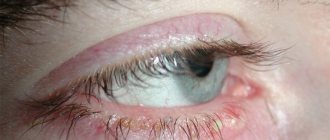132
Author of the article
Tsareva Elena Vladimirovna
Reading time: 8 minutes
A A
Conjunctivitis is an inflammation of the eyes that is familiar to most people. Its treatment may take from 5-7 days to 4-6 weeks. It depends on the causes and severity of the disease, as well as the measures the person resorts to to eliminate the disease. In allergic conjunctivitis, the duration of the disease depends on the source of the problem and the ability to remove or avoid it, and in chronic cases, therapy can last several years.
- On what factors does treatment time depend?
- Duration of course and therapy
- Viral
- Bacterial
- Gribkovogo
- Allergic
- Treatment
- What to do if it lasts a long time?
- Conclusion
Conjunctivitis with coronavirus: does it happen or not?
Pain in the eyes, active lacrimation, redness and burning are signs characteristic of conjunctivitis of any known form. They often occur during acute respiratory infections and may be a sign of coronavirus. This is often the first sign of pathogen activity in the human body.
Attention!
According to statistics, about 30% of patients who recovered from COVID-19 complained to doctors about discomfort with vision. Often this problem persisted for a long time - up to 2 weeks.
Definitely, conjunctivitis can occur during coronavirus infection, and these are not exceptional cases. Everything is easily explained from a medical point of view. The pathogen enters the human body through mucous membranes, including through the eyes. That is why the general recommendations for preventing the spread of COVID-19 clearly state that you should not touch your face with dirty hands.
Prevention
In most cases, conjunctivitis is not a serious problem, as it heals quite quickly and, as a rule, without consequences. That is why it is important to observe the rules of personal hygiene:
- do not use other people's equipment;
- keep your hands clean;
- avoid contact with sick people.
The problem is the contagiousness of the disease: you can get infected with bacterial or viral conjunctivitis quite easily.
Those children whose health is weakened by numerous diseases and children with weak immunity are also susceptible to frequent inflammation. This suggests that it is necessary to support the child’s health with vitamins, especially during the “peak” period of colds.
If you start treating conjunctival inflammation in time, the risk of complications will be minimal. To prevent infection, it is necessary to follow the rules of personal hygiene, do not touch your face and eyes with dirty hands, use an individual towel and avoid using other people’s cosmetics, lenses and care items.
Prevention measures:
- Use personal hygiene products
- Wash your hands after going outside
- During epidemics, strengthen your baby’s immunity with vitamins
- Get your vaccinations on time
- Don't let your baby touch his eyes with dirty hands.
- Limit communication between a healthy child and a sick child
- If you have allergies, try to exclude your baby from contact with allergens.
- Be sure to plan your pregnancy so that your child does not become infected with gonococcal or chlamydial conjunctivitis
How it proceeds
Conjunctivitis is the most common ophthalmological disease, which, with proper treatment, does not pose a danger to the visual organs and goes away quickly. This is an inflammatory process that affects the thin mucous membranes lining the eyeballs and eyelids from the inside. Against the background of the disease, small capillaries expand, their permeability increases, and the patient’s eyes turn red.
The eye infection occurs in a fairly mild form. Symptoms in the form of purulent discharge and other signs aggravating the clinical picture occur only in persons with weakened immune systems. To restore full functions of the eye, it is enough to use anti-inflammatory and antiviral ophthalmic ointments and drops.
Attention!
In case of complications in the form of purulent discharge, local use of antibiotics is indicated.
Treatment
In most cases, with the exception of chronic ones, treatment is successful and complications are rare. To the question of how to treat conjunctivitis, you can answer this: for mild forms, folk remedies are excellent; for more complex forms, it is important to consult a doctor in time and undergo a full course of diagnostics and therapy.
Depending on the type, conjunctivitis is cured in the following ways:
- The bacterial infection goes away after a course of tetracycline-based antibiotics. For treatment, medications such as ofloxacin, ciprofloxacin, and lomefloxacin are prescribed.
- Staphylococcal infection goes away after washing with antiseptic agents (furatsilin).
- Eye drops with a 0.05% solution of deoxyribonuclease or a solution of 20-30% sodium sulfacyl help overcome the virus.
- Allergies are treated with specially prescribed antihistamines
Causes of conjunctivitis
Conjunctivitis is a separate disease, but today it is designated as a symptom typical of COVID-19. At the same time, it can begin not only due to the activity of the coronavirus. Often the problem is provoked by other factors: bacterial and fungal infections, allergies, injuries, autoimmune processes.
In adult patients, the pathology manifests itself in a mild form with ARVI and influenza, which is explained by the presence of chronic blepharitis, dacryocystitis or dry eye syndrome. In children, the disease progresses due to viral and bacterial activity. Pathogens penetrate the mucous membrane through contact with unwashed hands.
What it is?
Conjunctivitis is an inflammatory disease of the mucous membrane of the eyeball (conjunctiva), caused by pathogenic bacteria, fungi, viruses and various allergens with which a person interacts in one way or another (household chemicals, cosmetics, medications, etc.). Symptoms of the disease may differ depending on the type of pathology; accordingly, the duration of the incubation period and the actual treatment for each case will be different.
Causes
The causes of inflammation of the mucous membrane are the following factors:
- Exposure to pathogenic fungi and bacteria that enter the conjunctival membrane (for example, when scratching the eye with unwashed hands, when using someone else’s decorative cosmetics, when hygiene rules are not followed when wearing contact lenses, etc.).
- A viral infection transmitted from another carrier or a sick person through close contact (for example, during a conversation, friendly hug, etc.). You can catch the viral form of the disease when attending mass events during epidemics. In this case, the pathogen may initially affect not the eye(s), but the nasal mucosa, subsequently spreading through the nasolacrimal duct.
- Allergic reactions to chemicals, medications, pollen of flowering plants, pet hair, etc. With allergic conjunctivitis, as a rule, both eyes are affected at once (severe itching, burning, redness of the mucous membrane), accompanied by sneezing, lacrimation and, in some cases, a rash on the skin.
- Traumatic factors, which include unfavorable weather conditions and, as a result, tiny particles of dust or sand getting into the eye, particles of plaster or paint getting into the eye during repairs, irritation of the mucous membrane when wearing lenses for a long time (without removing them at night), etc.
Provoking factors include weakened immunity, colds, frequent stress, hypothermia, etc.
Symptoms of conjunctivitis with coronavirus
The general clinical picture of inflammatory eye pathology includes the following symptoms:
- redness of the white of the eye;
- sensitivity to sunlight;
- lacrimation;
- pain in the eyes;
- blurred vision, slight decrease in visual acuity;
- the appearance of spots and spots before the eyes.
Attention!
Against the background of a viral infection and a decrease in the ability of the immune system to repel viral attacks, purulent discharge may appear.
The listed symptoms are typical for conjunctivitis, and their appearance is explained by damage to the retina and optic nerve. Ophthalmologists say that a decrease in visual acuity should not be a cause for panic. This often occurs due to changes in tear composition, muscle spasms, and swelling. These changes disappear without additional intervention after recovery.
When treatment for a viral form of pathology is delayed
Viral conjunctivitis usually develops against the background of acute respiratory viral infections or acute respiratory infections. This form can be highly contagious, especially if not treated promptly and adequately. Infection from a sick person to a healthy person occurs through hygiene and household items or aerogenously.
How many days will pass until complete recovery depends on the patient’s immune system. Some require five to seven days; treatment of conjunctivitis in young children with immature immunity can take up to two months. Antiviral drugs are prescribed, as well as vitamins and immunomodulators. Eyes should be washed regularly with disinfectant solutions. From pharmaceutical remedies, Furacilin is suitable, from folk remedies - a decoction of chamomile, sage, calendula.
Folk remedies for inflammation of the eye mucosa for rinsing and compresses can also be very useful
It is necessary to treat viral conjunctivitis; if the disease drags on, the risk of complications increases, in particular, deterioration of vision, up to its complete loss. In addition, such a patient is extremely dangerous for the people around him.
How many days does conjunctivitis last?
Viral conjunctivitis can go away without therapeutic intervention, but if it occurs against the background of COVID-19, it is not worth the risk. The disease may get worse because the immune system is weakened. Recovery often takes more than 2 weeks. Some patients complain of vision problems within a month after the disease. Ophthalmologists assure that the functioning of the eyes will fully improve only after the body recovers from the coronavirus. Specialized ophthalmic drugs help to significantly reduce the period of restoration of visual functions. They should be used as prescribed by a doctor.
FAQ:
1. How many days does the temperature last for conjunctivitis?
It depends on the form of the disease.
In some cases, the body temperature does not rise, or, on the contrary, remains for 1-7 days (for example, with a viral or bacterial form).
2. How many days should I use eye drops?
The duration of treatment is determined by the doctor and depends on the drug.
Over-the-counter drops can be used until symptoms disappear, and antifungal drops or antibiotics can be used in a strictly prescribed course.
Signs of the disease
Typical manifestations of inflammation in the eye are the following:
- tearfulness;
- sensation of irritation, foreign body in the eye;
- intolerance to bright light;
- swelling of tissues;
- severe itching;
- purulent discharge, especially after sleep.
Symptoms do not appear immediately, but reach their maximum literally 2–3 days after the activation of pathogens.
Duration of bacterial conjunctivitis
The disease begins with the contact of pathogenic bacteria (staphylococcus, pneumococcus, gonococcus and chlamydia) on the protective mucous membrane of the organ of vision.
Staphylococcal infection
One of the common forms of bacteria that provokes conjunctivitis in people with suppressed immunity. The main features are:
- sticky eyelashes in the morning;
- abundant purulent compartments.
Inflammation of this type of disease with adequate therapy can be treated in a short time. The healing process takes 5–6 days.
Pneumococcal infection
Conjunctivitis caused by this pathogenic microbe is expressed most acutely:
- significant swelling of the eyelids and the protective mucous layer of the eye;
- a sharp increase in temperature;
- grayish purulent discharge.
Duration of therapy
Viral diseases are easy to treat, but for a quick positive effect, a pedantic approach to the use of prescribed medications is required: do not skip drops, regularly apply ointment to the conjunctiva and, of course, monitor the condition of the body, i.e. do not get too cold, limit excessive activity, eat well.
Herpetic
Includes local and general therapy. The first is aimed at reducing symptoms, and the second at increasing the body's resistance to viruses. Herpes appears and begins to bother a person because the immune system is weakened, so this disease will go away the moment the patient is able to overcome it. It is difficult to predict the exact timing of treatment for the disease; it can vary from several weeks to a couple of months .
Adenoviral
An adenoviral eye infection behaves in exactly the same way as the familiar viruses that affect the throat or nose. On average, within 3-6 days of proper drug treatment, the infection goes away. A longer course indicates the addition of a secondary infection and is a reason to urgently visit a doctor.
Epidemic
Treatment lasts from 5 to 20 days. The duration of therapy depends not only on the condition of the body, but also on the stage at which the patient consulted a doctor.

